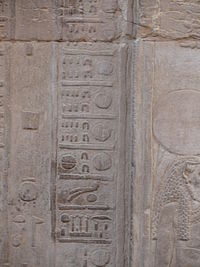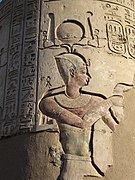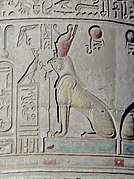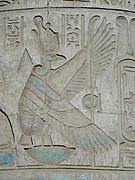


The Temple of Kom Ombo is an unusual double temple in the town of Kom Ombo in Aswan Governorate, Upper Egypt. It was constructed during the Ptolemaic dynasty, 180–47 BC. Some additions to it were later made during the Roman period.
Architecture
The building is unique because its 'double' design meant that there were courts, halls, sanctuaries and rooms duplicated for two sets of gods. The southern half of the temple was dedicated to the crocodile god Sobek, god of fertility and creator of the world with Hathor and Khonsu. Meanwhile, the northern part of the temple was dedicated to the falcon god Haroeris ("Horus the Elder"), along "with Tasenetnofret (the Good Sister, a special form of Hathor or Tefnet/Tefnut) and Panebtawy (Lord of the Two Lands)". The temple is atypical because everything is perfectly symmetrical along the main axis.
Decorations
The texts and reliefs in the temple refer to cultic liturgies which were similar to those from that time period. The temple itself had a specific theology. The characters invoked the gods of Kom Ombo and their legend. Two themes were present in this temple: the universalist theme and the local theme. The two combine to form the theology of this temple. A temple was already built in the New Kingdom to honor these gods, however, this site gained in importance during the Ptolemaic Kingdom. Little remains of the New Kingdom temple. The existing temple was begun by Ptolemy VI Philometor (180–145 BC) at the beginning of his reign and added to by other Ptolemies, most notably Ptolemy XIII Theos Philopator (51–47 BC), who built the inner and outer hypostyles. The scene on the inner face of the rear wall of the temple is of particular interest, and "probably represents a set of surgical instruments".
Current state
Much of the temple has been destroyed by the Nile, earthquakes, and later builders who used its stones for other projects. Some of the reliefs inside were defaced by Copts, who once used the temple as a church. All the temples buildings in the southern part of the plateau were cleared of debris and restored by Jacques de Morgan in 1893.
Crocodile Museum
A few of the three hundred crocodile mummies discovered in the vicinity are displayed in The Crocodile Museum.
In April 2018, the Egyptian Ministry of Antiquities announced the discovery of the head of the bust of Roman Emperor Marcus Aurelius during work to protect the site from groundwater.
In September 2018, the Egyptian antiquities ministry announced that a sandstone sphinx statue had been discovered at the temple. The statue, measuring approximately 28 cm (11 in) in width and 38 cm (15 in) in height, likely dates to the Ptolemaic Dynasty.
Gallery
-
 Kom Ombo Temple before reconstruction
Kom Ombo Temple before reconstruction
-
 A well-preserved frieze inside Kom Ombo temple
A well-preserved frieze inside Kom Ombo temple
-
 Overview of the Temple
Overview of the Temple
-
 Ptolemy VI Philometor makes an offering to Hathor and Horus at Kom Ombo
Ptolemy VI Philometor makes an offering to Hathor and Horus at Kom Ombo
-
 Preserved papyrus shaped column and ceiling at Kom Ombo temple
Preserved papyrus shaped column and ceiling at Kom Ombo temple
-
 Kom Ombo Temple
Kom Ombo Temple
-
The Crocodile Museum
-
 Shadoof beside Kom Ombo temple
Shadoof beside Kom Ombo temple
-
Ancient graffito on a temple stone
-
Kom Ombo, column detail
-
 Kom Ombo, column detail
Kom Ombo, column detail
-
 Kom Ombo, column detail
Kom Ombo, column detail
-
Ceiling Kom Ombo
-
 Kom Ombo, crocodile head
Kom Ombo, crocodile head
-
Sobek relief
See also
- List of ancient Egyptian sites, including sites of temples
References
- Rosalie David, Discovering Ancient Egyptology, Facts on File, 1993. p. 99
- ^ David, p. 99
- Wilkinson, Richard H. The Complete Gods and Goddesses of Ancient Egypt
- ^ Gods and Men in Egypt 3000 BCE to 395 CE
- "Crocodile Museum opens in Aswan - Museums - Heritage - Ahram Online". english.ahram.org.eg. Retrieved 2018-09-17.
- "Archaeologists find bust of Roman emperor in Egypt dig in Aswan". Arab News. 2018-04-22. Retrieved 2020-12-28.
- "Shrine to Osiris and bust of Roman emperor found in Egypt". www.digitaljournal.com. 2018-04-22. Retrieved 2020-12-28.
- DPA, Daily Sabah with (2018-04-22). "Archeologists find Roman emperor bust, ancient shrine in Egypt". Daily Sabah. Retrieved 2020-12-28.
- "Archaeologists find sphinx at Egypt temple". BBC News. 2018-09-17. Retrieved 2018-09-17.
External links
- fotopedia.com, Selected photos of the Temple of Kom Ombo
24°27′07″N 32°55′41″E / 24.45194°N 32.92806°E / 24.45194; 32.92806
Categories: